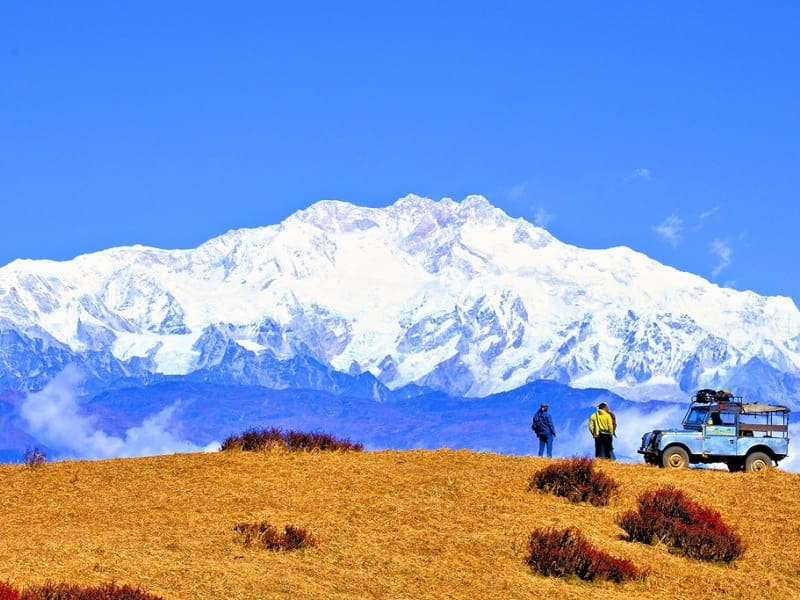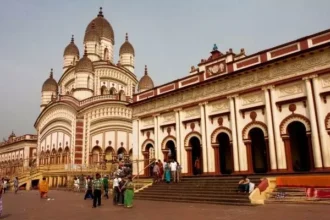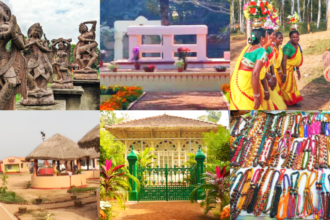Nestled in the eastern Himalayas, Sandakphu is a breathtaking destination located at an altitude of 12,000 feet (3,658 meters) in the Singalila National Park of West Bengal, India. Known as the “Roof of West Bengal,” Sandakphu offers unparalleled views of the majestic Himalayan range, including four of the world’s five highest peaks—Mount Everest, Kanchenjunga, Lhotse, and Makalu. For trekkers, nature lovers, and adventure seekers, Sandakphu is a dream come true. In this article, we’ll explore the top 5 places to visit in Sandakphu , ensuring your journey through this pristine region is nothing short of extraordinary.
1. Sandakphu Viewpoint: The Crown Jewel of the Eastern Himalayas
A Panoramic Feast for the Eyes
The Sandakphu Viewpoint is the ultimate highlight of any trip to this region. As the highest peak in West Bengal, it offers a 360-degree panoramic view of the Himalayan range. On clear mornings, you can witness the golden sunrise illuminating the snow-capped peaks, creating a surreal and unforgettable experience.
From this vantage point, you can marvel at the towering giants of the Himalayas:
- Mount Everest : The world’s highest peak stands majestically in the distance.
- Kanchenjunga : The third-highest peak appears closer than ever, almost within arm’s reach.
- Lhotse and Makalu : These neighboring peaks add to the grandeur of the landscape.
The sheer scale and beauty of these mountains leave visitors awestruck, making it one of the most sought-after viewpoints in the world. Photographers flock here to capture the interplay of light and shadow on the peaks, while spiritual seekers find solace in the serene ambiance.
Trekking to Sandakphu
Reaching Sandakphu requires a trek through dense forests, rhododendron groves, and alpine meadows. The most popular route begins from Maneybhanjang , a small town at the base of the hills, and takes about two days to complete. Along the way, you’ll pass through charming villages like Tumling and Kalpokhri , each offering its own unique charm.
For those who prefer a less strenuous journey, jeeps are available up to certain points, but the trek remains the best way to fully immerse yourself in the natural beauty of the region. The trail is dotted with resting spots where you can pause to admire the scenery or sip on hot chai served by local vendors.
Key Highlights Along the Trek
- Rhododendron Forests : During spring (March to May), the forests burst into vibrant hues of red, pink, and white as rhododendrons bloom.
- Tea Stalls and Local Cuisine : Small tea stalls along the route serve steaming cups of masala chai and simple snacks like pakoras and momos.
- Wildlife Encounters : Keep an eye out for red pandas, Himalayan black bears, and various bird species that inhabit the area.
“At Sandakphu, the sky feels closer, and the mountains seem alive with stories of time.”
2. Singalila National Park: A Biodiversity Hotspot
A Haven for Wildlife Enthusiasts
Singalila National Park , home to Sandakphu, is a UNESCO World Heritage Site and one of the most biodiverse regions in the eastern Himalayas. Spanning over 78 square kilometers, the park is a sanctuary for rare flora and fauna, making it a paradise for wildlife enthusiasts and photographers.
Flora and Fauna
The park is renowned for its rich vegetation, including dense bamboo forests, oak trees, and vibrant rhododendron blooms that paint the hills red and pink during spring (March to May). Keep an eye out for endangered species such as:
- Red Panda : This adorable mammal is a symbol of conservation efforts in the region. Spotting one in the wild is considered a rare privilege.
- Clouded Leopard : Though elusive, sightings of this majestic cat are considered a rare treat for wildlife enthusiasts.
- Himalayan Black Bear : Often spotted foraging in the undergrowth, these bears are a common sight during autumn when they prepare for hibernation.
Birdwatchers will be delighted by the diversity of avian life, including species like the blood pheasant , satyr tragopan , and fire-tailed sunbird . The park is also home to several migratory birds that flock here during winter.
Adventure Activities
In addition to trekking, visitors can enjoy birdwatching, camping, and guided nature walks within the park. The serene environment and crisp mountain air make it an ideal location for meditation and mindfulness practices. Many tour operators organize overnight camping trips, allowing visitors to sleep under the stars and wake up to the sound of chirping birds.
Conservation Efforts
Singalila National Park plays a crucial role in preserving the fragile ecosystem of the eastern Himalayas. Strict regulations are in place to minimize human impact, and eco-friendly tourism initiatives ensure that the park remains pristine for future generations.
“Singalila National Park is not just a protected area; it’s a living testament to the wonders of nature.”
3. Tumling Village: A Glimpse into Local Life
Cultural Immersion
Tumling , a quaint village located along the Sandakphu trekking route, offers a glimpse into the lives of the indigenous Lepcha and Sherpa communities. Nestled amidst lush greenery and terraced fields, this village exudes warmth and hospitality.
Local Hospitality
Homestays in Tumling provide travelers with an authentic experience of rural mountain life. Hosts often serve traditional Nepali and Tibetan dishes, such as thukpa (noodle soup), momos (dumplings), and gundruk ko jhol (fermented leaf soup). Sharing meals with locals fosters a deeper connection to the culture and traditions of the region.
Many homestay owners share fascinating stories about their ancestors’ migration from Tibet and Nepal, adding a historical dimension to your stay. Visitors are also encouraged to participate in daily activities like farming, cooking, and weaving, gaining firsthand insights into the community’s way of life.
Scenic Beauty
The village itself is surrounded by breathtaking views of the Himalayas and verdant valleys. Early risers can enjoy the mist rolling over the hills, creating a magical atmosphere. Evening bonfires accompanied by folk songs and dances are common, adding to the charm of the stay.
Activities Around Tumling
- Short Hikes : Explore nearby trails that lead to hidden waterfalls and scenic viewpoints.
- Photography : Capture the rustic charm of the village and its picturesque surroundings.
- Cultural Programs : Participate in traditional dance performances and storytelling sessions organized by the villagers.
“In Tumling, every moment feels like stepping into a postcard of serenity and simplicity.”
4. Phalut: The Next Frontier of Adventure
Beyond Sandakphu
While Sandakphu steals the spotlight, Phalut , located further along the trekking route, is equally mesmerizing. At an elevation of 11,800 feet (3,600 meters), Phalut offers uninterrupted views of the Himalayan range and serves as a gateway to the remote corners of the Singalila Ridge.
Unique Features
Unlike Sandakphu, Phalut is less crowded, making it perfect for those seeking solitude. The trail leading to Phalut passes through alpine meadows dotted with wildflowers, streams, and rocky terrains. During winter (December to February), the entire landscape transforms into a snowy wonderland, attracting adventure enthusiasts for snow trekking.
Why Visit Phalut?
- Stunning Views : The panoramic vistas of Mount Everest, Kanchenjunga, and other peaks are equally spectacular from Phalut.
- Remote Wilderness : The isolation and untouched beauty of Phalut make it a favorite among seasoned trekkers.
- Starlit Nights : With minimal light pollution, Phalut offers some of the clearest night skies in the region, perfect for stargazing.
Camping and Stargazing
Phalut is renowned for its clear night skies, making it an excellent spot for stargazing. Campers often set up tents here to spend the night under a blanket of stars, listening to the sounds of nature. Guided astronomy sessions are occasionally organized, providing insights into constellations and celestial phenomena.
Winter Adventures
During the winter months, Phalut becomes a hub for snow trekking and photography. The snow-covered trails and frost-laden trees create a fairy-tale-like setting, drawing adventurers from across the globe.
“Phalut is where the mountains whisper secrets to those willing to listen.”
5. Rimbi Waterfall: A Hidden Gem Near Sandakphu
Nature’s Symphony
Located near the base of the Sandakphu trekking route, Rimbi Waterfall is a hidden gem tucked away in the lush forests of Darjeeling district. This cascading waterfall plunges from a height of approximately 50 feet, creating a soothing melody as water meets rock.
Activities and Attractions
Visitors can take a refreshing dip in the pool below or simply relax by the falls, enjoying the cool mist and tranquil ambiance. The surrounding forest is home to diverse plant and animal species, making it a great spot for short hikes and photography.
During monsoon season (June to September), the waterfall swells with water, becoming even more spectacular. However, the trails can get slippery, so caution is advised. The lush greenery and vibrant flowers surrounding the waterfall make it a photographer’s paradise.
How to Reach Rimbi Waterfall
Rimbi Waterfall is accessible via a short drive from Maneybhanjang or a trek through the forest. While it may require some effort to reach, the reward is well worth it—a secluded oasis of calm and beauty.
Tips for Visiting
- Wear sturdy shoes as the path can be uneven and muddy.
- Carry insect repellent to ward off mosquitoes and leeches during the rainy season.
- Bring a waterproof jacket if visiting during monsoon.
“Rimbi Waterfall is a reminder of nature’s ability to heal and rejuvenate.”
Why Sandakphu Should Be on Your Travel Bucket List
Sandakphu is a destination that caters to diverse interests—whether you’re a trekker seeking adventure, a photographer chasing the perfect shot, or someone looking to reconnect with nature. Its unspoiled landscapes, rich biodiversity, and warm local hospitality make it a must-visit for anyone traveling to the eastern Himalayas.
Whether you’re standing atop Sandakphu, gazing at the mighty Himalayas, or immersing yourself in the tranquility of Tumling and Phalut, every moment spent in this region leaves an indelible mark on your heart.
“Sandakphu is not just a place; it’s an emotion—a journey that redefines your relationship with nature.”
Frequently Asked Questions (FAQs)
1. What is the best time to visit Sandakphu?
The best time to visit Sandakphu is between March and May (spring) and October to December (autumn) when the weather is pleasant and the skies are clear.
2. How do I reach Sandakphu?
The nearest railhead is New Jalpaiguri Junction (NJP), followed by a road journey to Maneybhanjang, the starting point of the trek. Alternatively, Bagdogra Airport is the closest airport.
3. Are there accommodation options in Sandakphu?
Yes, basic accommodations such as homestays, lodges, and campsites are available along the trekking route, including in Tumling and Phalut.
4. Is Sandakphu suitable for beginners?
Yes, the trek to Sandakphu is moderate and suitable for beginners, though a reasonable level of fitness is recommended.
5. Can I cover all five places in one trip?
Absolutely! Most treks to Sandakphu include stops at Tumling, Phalut, and Rimbi Waterfall, allowing you to explore multiple attractions in a single journey.
6. Are these places family-friendly?
Yes, all five destinations are family-friendly, though younger children may require assistance during the trek.
7. Do I need a guide to explore Sandakphu?
While not mandatory, hiring a local guide enhances safety and provides valuable insights into the region’s flora, fauna, and culture.
8. What should I pack for a trip to Sandakphu?
Essential items include sturdy trekking shoes, warm clothing, rain gear, sunscreen, sunglasses, a camera, and a first-aid kit.
9. Are permits required to visit Sandakphu?
Yes, permits are required to enter Singalila National Park, which can be arranged through registered tour operators.
10. Can I shop for souvenirs in Sandakphu?
While shopping options are limited, you can purchase handmade crafts, woolen items, and local teas from nearby villages.















buy amoxicillin sale – https://combamoxi.com/ buy amoxil without prescription